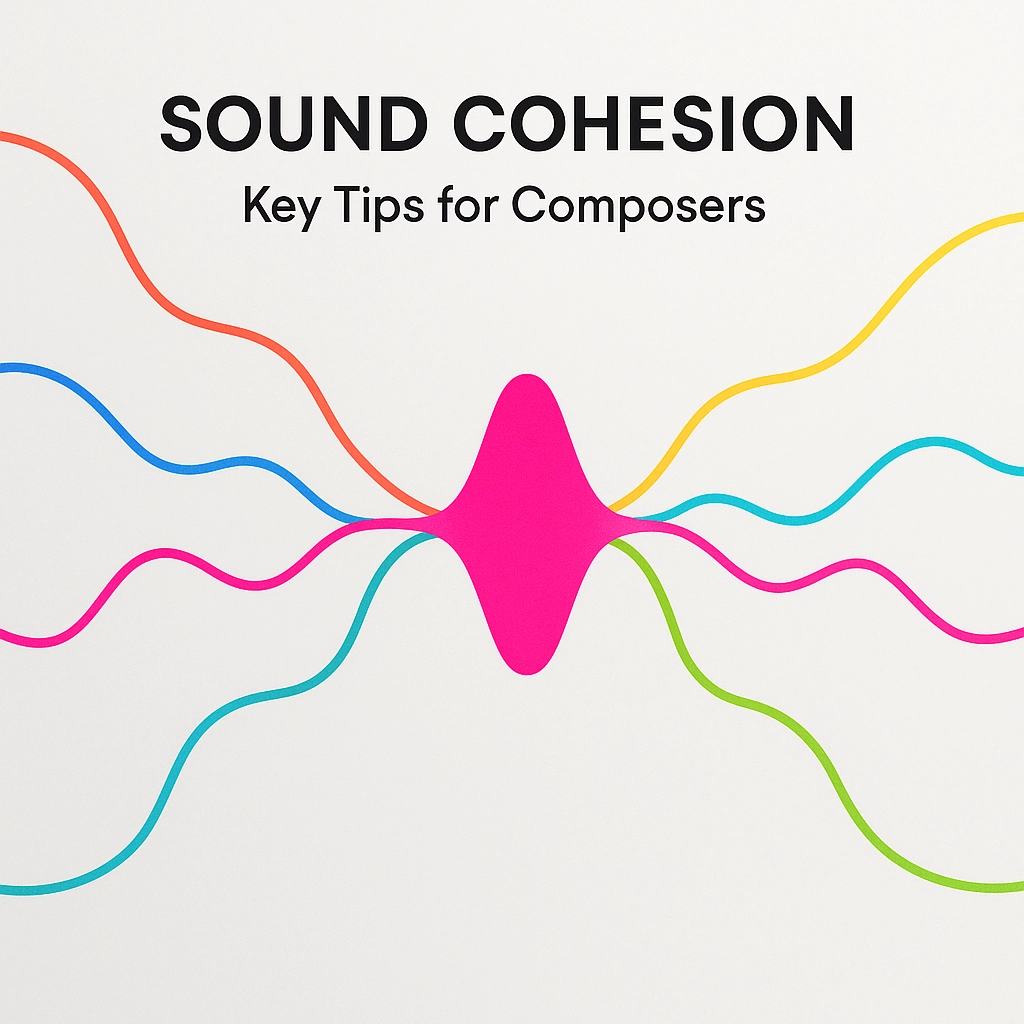
On Mixing and Sound Cohesion: Persuade the Ear
- Posted by Filip Sijanec
- Date September 3, 2025
- Comments 0 comment
⏱️ Reading time: 6 minutes
Ever notice how some mixes just sound right? How every instrument feels like it belongs, even when you’re dealing with samples from different libraries, recorded at different times, in different spaces? That’s the magic of sound cohesion: and it’s something every composer needs to master, whether you’re preparing for NFTS entrance exams, working on professional film composition, or diving into 1:1 composition lessons.
The secret isn’t about having the most expensive samples or the fanciest gear. It’s about understanding how to “persuade the ear” that everything belongs together. Let’s break down the four essential principles that’ll transform your mixes from amateur to professional.
Make Everything Sound Like It’s in the Same Room
Here’s the thing: your ear is incredibly smart at detecting inconsistencies. When you layer a dry violin sample over a reverberant orchestral percussion, your brain immediately flags it as “fake.” This is where the concept of persuading the ear becomes crucial.
Think of mixing as creating an acoustic illusion. You’re convincing the listener that your string section, brass, woodwinds, and percussion were all recorded in the same legendary space: whether that’s Abbey Road, Air Studios, or your imagined concert hall.
How do you achieve this? Start by analysing the natural reverb and room tone in your existing samples. If your brass samples have a cathedral-like reverb tail, your strings need to match that same acoustic signature. If your percussion sounds intimate and close, everything else should feel equally present.
For film scoring lessons, this principle is absolutely critical. Directors and producers can instantly tell when a score feels “cobbled together” from mismatched elements. Your job is to create seamless sonic landscapes that serve the story, not distract from it.
Practical tip: Load up a reference track from a film composer you admire. Notice how every element feels like it exists in the same acoustic environment, even though it was likely assembled from dozens of different sources.
Consistency Trumps Perfection Every Time
This might be the most liberating concept for developing composers: you don’t need perfect samples to create convincing music. A coherent mix using basic libraries will always sound more professional than an incoherent mix using the world’s most expensive samples.
I’ve seen students obsess over finding the “perfect” violin library while completely ignoring how their existing strings work with their brass and woodwinds. This is backwards thinking. Focus on making your existing tools work together harmoniously before upgrading your arsenal.
Why does consistency matter so much? Because your ear adapts to the sonic signature you establish. Once listeners accept the “sound world” you’ve created in the first few seconds, they’ll follow you anywhere within that established framework.
For those preparing portfolio guidance for film schools or RCM entrance exams, remember: admissions panels aren’t judging your sample libraries: they’re evaluating your musical decisions and technical competency. A well-crafted piece using modest tools will always outshine a poorly mixed piece with premium samples.
Ask yourself: Does every instrument in your mix feel like it was recorded under similar conditions? If your oboe sounds like it’s in a concert hall while your French horns sound like they’re in your bedroom, you’ve got work to do.
The Magic of Shared Reverb
Here’s where many composers go wrong: they treat reverb like seasoning, sprinkling different types across different instruments. But reverb isn’t just an effect: it’s the acoustic glue that binds your entire mix together.
Start with one shared reverb send. Route all your instruments to this common space before you even think about adding additional character reverbs. This creates the foundational acoustic environment where your virtual ensemble “performs.”
Think of it like this: if you were recording a real orchestra, all the musicians would be sharing the same hall reverb naturally. Your samples need to replicate this shared acoustic fingerprint.
Once you’ve established this common space, then you can experiment with additional reverbs for creative effect. Want your solo violin to have extra intimacy? Add a subtle plate reverb. Need your brass to feel more dramatic? Layer in some additional hall reverb. But always maintain that foundational shared space that ties everything together.
This technique is especially crucial for film composer mentorship work. Professional composers understand that the reverb isn’t just making things sound “pretty”: it’s creating the sonic architecture that supports the emotional narrative of the scene.
First Impressions Are Everything
Your mix has about three seconds to convince a listener that it’s professional. That’s it. If something feels off in those opening moments: like a bone-dry accordion suddenly appearing after lush, reverberant congas: you’ve lost them.
Why are first impressions so crucial? Because once the ear detects an inconsistency, it starts listening analytically rather than emotionally. Instead of getting lost in your music, listeners start dissecting your technical choices. That’s the opposite of what you want.
This principle becomes even more critical when you’re working in professional contexts. Film directors, game developers, and music supervisors make snap judgments. If your demo sounds amateur in the first few seconds, they’re moving on to the next composer before your best musical ideas even appear.
Practical approach: Play your mix for someone who’s never heard it before. Watch their face during those crucial opening moments. Do they seem engaged and drawn in, or do you notice a subtle frown or distraction? Trust their initial reaction: it’s usually accurate.
For 1:1 composition lessons, I always emphasise this point: your opening needs to establish credibility immediately. Every element that appears in those first bars needs to feel cohesive and intentional.
Putting It All Together
These four principles work synergistically. When you create a shared acoustic space, maintain consistency across your sample choices, use common reverb to glue everything together, and nail those crucial first impressions, something magical happens: your music stops sounding like a collection of samples and starts sounding like music.
Your action steps: Take your current work-in-progress and apply these principles systematically. First, analyse whether all your elements feel like they exist in the same acoustic space. Second, identify any samples that break the sonic consistency and either replace them or process them to match. Third, strip away all your reverbs and start fresh with one shared send. Finally, focus obsessively on those opening moments until they feel completely natural and professional.
Whether you’re preparing for professional film composition opportunities or building skills for film scoring lessons, mastering sound cohesion isn’t optional: it’s the foundation that everything else builds upon. Your technical proficiency, harmonic sophistication, and melodic gifts all depend on this fundamental skill of making disparate elements feel unified.
Remember: you’re not just arranging notes on a page. You’re crafting sonic experiences that need to feel inevitable, natural, and emotionally compelling. Master these principles, and you’ll find that your music doesn’t just sound better: it persuades listeners to believe in the world you’ve created.
Start applying these techniques today. Your ears: and your audience( will thank you.)
Filip Sijanec is an award-winning composer and educator based in London. He serves as Professor at the Royal College of Music and NFTS, and teaches composition and music technology at ICMP and ThinkSpace, mentoring aspiring composers. He is the composer for an Oscar-nominated film and creates original music for film, games, theatre, and commercials.
You may also like

How to Compose Music for Films

How to Compose Music for Video Games

